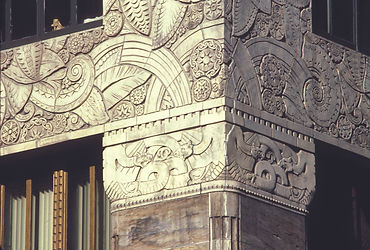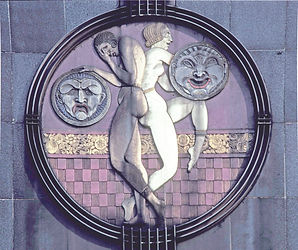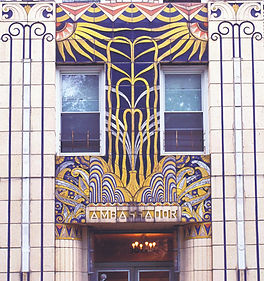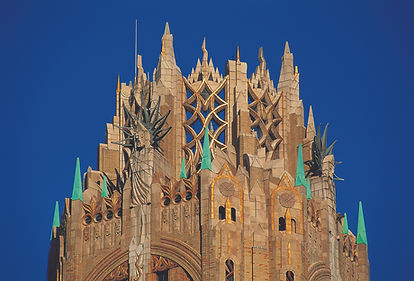The sweeping changes that occurred in American architecture during the Art Deco era—especially in New York—were greatly amplified by the versatile qualities of terra cotta, a material that brought a new expressiveness to the buildings and skylines of cities across America. The earliest use of terra cotta in American architecture—in the early nineteenth century—was to embellish the design of façades and rooflines of predominantly brick buildings. The resurgence of terra cotta ornament on brick buildings during the 1920s and 1930s illustrates how the material’s use came full circle. While earlier American architects used terra cotta to imitate stone, wood or metal details on masonry buildings, by the 1920s the material was utilized to create the most eye-catching ornament possible. Architects of the period exploited its varied and unique decorative qualities.
Terra cotta, literally “burnt earth,” is a term that has been used loosely since Roman times to refer to ceramic ware intended primarily for architectural elements and large-scale statuary. Due principally to the plasticity of clay, which allows any decorative motif to retain its fine details when being translated from a two-dimensional drawing into three-dimensional form, terra cotta can be modeled easily into nearly any form or size.
Although the modern tradition of ornamenting building façades and rooflines with terra cotta—either in its natural clay colors or glazed with matte or glossy finishes—dates to the early century, by the interwar years a fresh range of glaze colors (such as yellow, green, and cobalt blue) and metallic lusters (such as gold and silver) were used to emphasize the period’s unique architectural detailing.
In ancient times, before glaze technology was developed, unglazed terra cotta achieved a variety of natural pigmentations resulting from trace elements such as iron that were present in clay deposits. By the 1920s, a century of technological experimentation had led to the development of sophisticated modern glazes in a bold palette. For the first time, color could be used for its own dazzling and decorative effects. This new attitude toward color—that it should stand out and attract attention—reflected the importance of ornament during this period. Art Deco, primarily a decorative style, was influenced by both modern artistic movements, such as Cubism, Futurism, the Bauhaus and Constructivism, and ancient cultures, including Egypt, Mesoamerica, Greece and Africa. Designs from nature were reduced to their fundamental geometric forms. Flowers and leaves became flattened semi-circles and spirals, while the lines and patterns within them became symmetrical rays or chevrons. The Art Deco decorative vocabulary also included motifs such as triangles, faceted diamonds, arcs, bubbles, ripples, and stepped ziggurats.
Although polychrome glazed terra cotta was first introduced into American architecture around 1900, strong color remained the exception rather than the rule for the next twenty years. Much of the architecture of the 1910s, which we often think of as monochromatic, did, in fact, incorporate colored terra cotta: for example, the ornament on Cass Gilbert’s Woolworth Building (1912), includes terra cotta motifs with blue, yellow, and green glazes. These colors, however, served primarily to articulate the building’s overall architectural design and blended discreetly into the overall stone-colored Gothic-inspired terra cotta cladding.
By the mid-1920s, architectural terra cotta came to be used frequently by forward-looking architects for a number of different reasons: it is fireproof, lightweight, readily available, and economical; it could also be used to create striking aesthetic effects. The use of colored glazes increased dramatically by the mid-1920s, when fashionable new shades such as peach, lime-green, lavender, and ebony were introduced. Metallic lusters, the result of an expensive double firing process—wherein a coating of liquid silver or gold was added to an already-glazed piece that was then re-fired at a lower temperature—were also developed. The interplay of such colored and textured glazes was used to both accentuate a building’s architectural form and highlight its low-relief ornament.

Corner detail from the eighteen-foot high terra cotta frieze on the Chanin Building (122 East 42 Street, NY, Sloan & Robertson, 1927–29)

This detail of the Woolworth Building (223 Broadway, NY, Cass Gilbert, 1913) provides a close look at the yellow and blue glazed terra cotta, which usually goes unnoticed on this fifty-two-story tower

Comedy and Tragedy Rondel, Metro Theater. (2624-2626 Broadway, NY, Boak & Paris, 1932–33)
Indeed, the Art Deco era’s demand for a flatter look—rather than the more dynamically sculptural works of earlier decades—led to the introduction of machine-extruded terra cotta units. Such pieces could be produced economically, as they required little hand labor, and they also were easy to install, a factor in considering a building’s construction costs. The very versatility of terra cotta helped make it an important element as the emerging, growing skyscraper style evolved and gained popularity during the interwar years.
Throughout the Art Deco era another contradictory approach was also common: more conservative architects who preferred to work in traditional or historical styles also understood the many advantages of terra cotta but further recognized the material’s ability to convincingly mimic more expensive building materials—it served as an excellent substitute material. By using different glazes, terra cotta could be made to look like granite, limestone, or marble, and often only the most astute building professional was able to recognize the actual material used. Terra cotta manufacturers promoted the range of surface finishes and introduced specialized glazes such as Granitex. Invented by Gladding McBean pottery works of San Francisco, the material recreated the color and texture of genuine granite.
This dual appeal of terra cotta is captured in archival photographs from the 1920s and 1930s. Images of models created by Isadore Kaplan, a sculptor who served as a modeler for the New York Architectural Terra Cotta Company from the early 1920s until 1931, show that he was equally adept at producing traditional historic ornament and fashionable Art Deco motifs. Two notable projects made within weeks of each other were his architectural details for 30 Beekman Place (1928–29, George Pelham) and for 944 Park Avenue (1928–29, Joseph Unger). The former is an apartment building in the Italian Renaissance style, while the latter is a typical Art Deco apartment building.
From its completion in 1912 until 1930, the fifty-two-story terra cotta-clad Woolworth Building remained the world’s tallest building. However, the arrivals of the even taller Chrysler Building (1930, William Van Alen) and the Empire State Building (1931, Shreve, Lamb & Harmon) brought an end to the widespread use of terra cotta as an exterior cladding material. Glazed terra cotta instead was restricted to decorative elements on façades and entrances, or for interiors. Many buildings of the period, especially those clad in brick, often used terra cotta in innovative ways, such as juxtaposing the material with glass, metal, mosaic tile, or even colored mirror. For example, New York’s Chanin Building (1929, Sloan & Robertson) features a spectacular stylized terra cotta frieze, designed by Rene Paul Chambellan, which spans the third and fourth stories. Further decoration, also by Chambellan, includes marble and copper bas-relief panels as well as a bronze frieze below the terra cotta ornamentation.

The metallic finish in combination with brilliant glaze colors creates a stunning entry to the Ambassador Apartments (30 Daniel Low Terrace, Staten Island, NY, Lucian Pisciotta, 1932)

A web of undulating terra cotta with gold luster creates an eccentric roofline on the GE Building (570 Lexington Avenue, NY, Cross & Cross, 1931)

This commercial brick structure (1220 Broadway, NY, Levy & Berger, 1931) is ornamented with glazed terra cotta floral motifs. The Empire State Building is in the background.
The monumentality of New York’s Art Deco high-rise apartment houses made a significant impact on how architects approached the design of these new buildings. Since such tall buildings were subject to regulation by the 1916 New York Zoning Resolution requiring setbacks, architects replaced elaborately ornamented cornices with innovatively designed setbacks and terraces. This shift away from elaborate cornices led architects to focus more on embellishing entrances or the building’s lower levels, which often boasted geometric patterning, faceted openings, and stylized floral detailing, executed in a variety of both traditional masonry materials, such as terra cotta, and new materials, such as aluminum alloys.
In addition to new materials, architects began to approach ornamentation in a new way: allegorically. Art Deco terra cotta motifs began to reflect the particular function of the building’s owner—often glorifying business, commerce and technology—while adding a note of whimsy that captured the wit and humor of designers and owners. Parking garages often had decorative terra cotta steering wheels or automobile tires on their façades; Carnegie Hall featured musical staffs and notes; and theaters were decorated with masks of comedy and tragedy.
One of New York’s most captivating examples of terra cotta iconography can be seen on the Radio Corporation of America (RCA Victor) Building, now the General Electric Building (1931, Cross & Cross,). Symbolic ornamentation on this structure includes a terra cotta phonograph needle, radio waves, lightning bolts and stylized human figures. To draw further attention to the terra cotta details, the architect incorporated strategically placed lighting within the building’s setbacks for effective nighttime illumination. The ability of glazed terra cotta to reflect light led the National Terra Cotta Society to feature the ornamental possibilities for sculpted forms in low relief in its promotional literature. Efforts were made to inspire architects, reminding them that “the ceramic industry holds within the nature of its material unexploited resources of the most promising nature.”
New York’s skyline, and particularly its Art Deco buildings, is treasured by those who appreciate abundant ornament. Because of continuing efforts to protect and preserve our architectural heritage, there is pleasure to be gained from seeking out the architectural styles of the past.

30 Beekman Place
(1928-29, Isadore Kaplan, New York Architectural Terra-Cotta Company

944 Park Avenue (1928-29, Isadore Kaplan, New York Architectural Terra-Cotta Company
About the Author:
Susan Tunick is an artist and President of Friends of Terra Cotta. One of her publications, Terra-Cotta Skyline (1997), won that year's New York Society Library Award and the Brandon Gill Award from The Municipal Art Society of New York.
All photos: Peter Mauss/Esto, unless otherwise noted.
Article originally published in the Art Deco New York journal, Vol. 2, Issue 1, Spring 2017. View a digital version of the full journal here.

